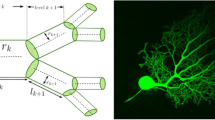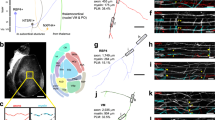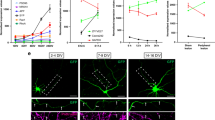Abstract
In the nervous systems of many animals, including vertebrates, isolated axon segments can survive for weeks or even months1–3; they can participate in regeneration4,5 and in some cases receive synapses from regenerating axons6,7. Axon segments in cell culture exhibit limited growth8–10. Although lengths of axon may grow in more intact systems11–14, direct evidence for this has been difficult to obtain, partly because of the difficulty of marking isolated axon segments. We have injected fluorescently labelled synthetic D-peptides15 into identified neurones in the leech central nervous system to mark axon segments. We report here that individual segments can initiate growth at both ends and grow for days, both in organ culture and in vivo. These results support the hypothesis that axon growth is not essentially polar and suggest a novel mechanism by which axon segments may assist nerve regeneration.
This is a preview of subscription content, access via your institution
Access options
Subscribe to this journal
Receive 51 print issues and online access
$199.00 per year
only $3.90 per issue
Buy this article
- Purchase on Springer Link
- Instant access to full article PDF
Prices may be subject to local taxes which are calculated during checkout
Similar content being viewed by others
References
Albuquerque, E. X., Deshpande, S. S. & Guth, L. Expl Neurol. 62, 347–373 (1978).
Anderson, H., Edwards, J. S. & Palka, J. A. Rev. Neurosci. 3, 97–139 (1980).
Matsumoto, D. E. & Scalia, F. J. comp. Neurol. 202, 135–155 (1981).
Hoy, R. R., Bittner, G. D. & Kennedy, D. Science 156, 251–252 (1967).
Muller, K. J. & Carbonetto, S. J. comp. Neurol. 185, 485–516 (1979).
Carbonetto, S. & Muller, K. J. Nature 267, 450–452 (1977).
Krasne, F. B. & Lee, S. H. Science 198, 517–519 (1977).
Levi, G. & Meyer, H. J. exp. Zool. 99, 141–181 (1945).
Shaw, G. & Bray, D. Expl Cell Res. 104, 55–62 (1977).
Wessells, N. K., Johnson, S. R. & Nuttall, R. P. Expl Cell Res. 117, 335–345 (1978).
Cajal, S. Ramon y (Hafner, New York, 1928).
Clark, R. D. J. comp. Neurol. 170, 253–266 (1976).
Birse, S. C. & Bittner, G. D. J. Neurophysiol. 45, 724–742 (1981).
Rotshenker, S. Brain Res. 223, 141–145 (1981).
Weisblat, D. A., Zackson, S. L., Blair, S. S. & Young, J. D. Science 209, 1538–1541 (1980).
Nicholls, J. G. & Baylor, D. A. J. Neurophysiol. 31, 740–756 (1968).
Kater, S. B. & Hadley, R. D. Soc. Neurosci. Abstr. 6, 686 (1980).
Speidel, C. C. Am. J. Anat. 52, 1–79 (1933).
Fuchs, P. A., Nicholls, J. G. & Ready, D. F. J. Physiol., Lond. 316, 203–223 (1981).
Parnas, I. & Bowling, D. Nature 270, 626–628 (1977).
Heuser, J. E. & Reese, T. S. J. Cell Biol. 57, 315–344 (1973).
Muller, K. J. & McMahan, U. J. Proc. R. Soc. B194, 481–499 (1976).
Muller, K. J. Biol. Rev. 54, 99–134 (1979).
Campenot, R. B. Proc. natn. Acad. Sci. U.S.A. 74, 4516–4519 (1977).
Gundersen, R. W. & Barrett, J. N. J. Cell Biol. 87, 546–554 (1980).
Chalfie, M. & Thomson, J. N. J. Cell Biol. 82, 278–289 (1979).
Grafstein, B. & Forman, D. S. Physiol. Rev. 60, 1167–1283 (1980).
Bisby, M. A. J. Neurochem. 36, 741–745 (1981).
Lasek, R. J., Gainer, H. & Barker, J. L. J. Cell Biol. 74, 501–523 (1977).
Miyazaki, S. & Nicholls, J. G. Proc. R. Soc. B194, 295–311 (1976).
Author information
Authors and Affiliations
Rights and permissions
About this article
Cite this article
Mason, A., Muller, K. Axon segments sprout at both ends: tracking growth with fluorescent D-peptides. Nature 296, 655–657 (1982). https://doi.org/10.1038/296655a0
Received:
Accepted:
Issue Date:
DOI: https://doi.org/10.1038/296655a0
Comments
By submitting a comment you agree to abide by our Terms and Community Guidelines. If you find something abusive or that does not comply with our terms or guidelines please flag it as inappropriate.



